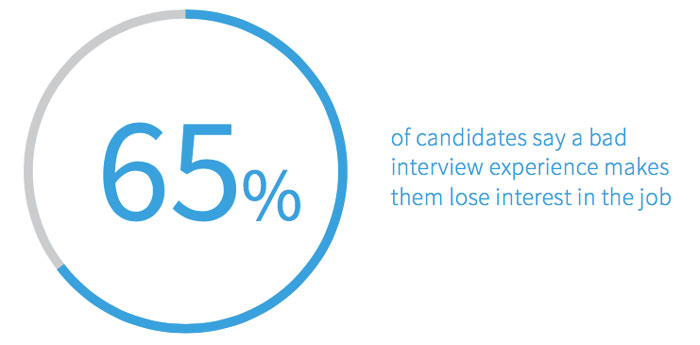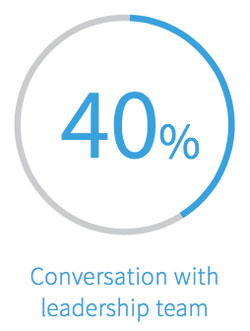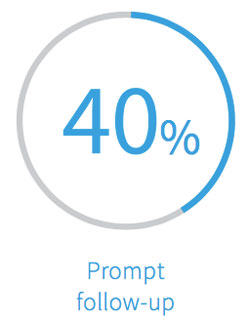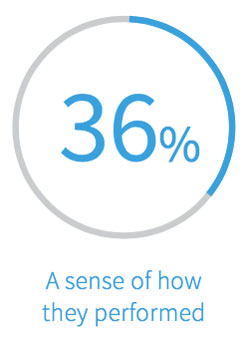
The interview process can make or break a candidate’s decision to join your company: 65% say a bad interview experience makes them question whether they want the job at all.

As a recruiter, you want to make sure your interview process is set up for success. The questions is: what do candidates really care about? Luckily, you no longer have to guess – as part of LinkedIn’s Inside the Mind of Today’s Candidate, we asked over 14,000 professionals questions about what they really want out of the hiring process, including the interview. Based on their responses, here are five super easy ways to improve your interview process.
1. Showcase your company culture by giving an office tour and letting candidates meet the hiring manager and other employees

Candidates are eager to learn about your company culture during interviews. It gives them an idea of what their day-to-day life would be like if they took the job, from the type of space they’d be working in to the people they’d be surrounded by. And more than half (51%) said an office visit is the best way to learn.
For onsite interviews, incorporating an office tour is easy and super effective. If the candidate can see themselves in the role, they’re more likely to accept an offer. Even if they aren’t hired, a pleasant visit can really improve their opinion of the company and their overall experience.
While the office visit is a draw, getting your hiring manager and employees involved is almost as important. Half the candidates surveyed wanted to hear about culture from the hiring manager, and 46% wanted to hear from current employees.
Look for ways to have them meet the team when they visit. Ask your hiring manager to chat to the candidate before or after the interview, and prep them to paint a great picture of working for the company. Inviting the candidate to a company picnic or other social event is also fun way for them to meet the people who might be their future co-workers.
And when it comes to interviewing candidates who can’t be there in person, there are still ways you can help them experience your office and culture. For example, Atlassian developed a virtual office tour that lets candidates sitting at home see what it’s like to work at there – how teams are organized, what desks and social areas look like. And the interactive component allows candidates to choose content that is relevant to them to make the experience more personal.
2. Talk about what matters most to candidates – especially the role responsibilities

70% of candidates say it’s most useful to learn about the responsibilities of the role during an interview.
If you’ve written a good job description, they should know a lot about the role already. The interview is an opportunity to fill in the gaps and get them excited. Make sure you’re ready to answer any questions they might have.
Beyond the role itself, 42% of candidates are curious to know if they’ll fit in with the team. They’re also equally interested in learning what the company’s mission and values are. So tell them what the company stands for, and share any exciting examples—like recent projects that are driivng your companies mission or stories of employees taking up passion projects or volunteering to advance that cause.
Of course, candidates want to find out about the salary, benefits, and potential career advancement, too. Swapping jobs is a big life decision and they need to know all the facts before an offer is on the table. 39% say that the salary and benefits discussion was a useful part of the interview, and 31% felt that way about career advancement, so don’t neglect these areas.
3. Make conversations with leaders a part of the interview

People tend to respond well to authority—which explains why 40% of candidates are eager to speak to the leadership team during the interview.
Getting your leadership team involved in the recruitment process can be as simple as a quick handshake and a few words during a visit. It could also be more in-depth, like a one-on-one meeting as part of the interview, showing the candidate that the leaders care and believe in being hands-on.
4. Respect candidate’s time with the right number of interviews and quick follow-up

Too few interviews can make your decision harder, but too many can start to wear a candidate out. Luckily, 84% of candidates say they are satisfied with the number of interviews they experience, which tends to be be about three.
According to research from Google, four interviews is more than enough to make an informed hiring decision—as long as you’re asking the right questions. So focus on refining the questions you’re asking, and don’t overload candidates with too many interviews.

After the interview, candidates value prompt follow-up, with 40% saying they want to hear from you soon.
The speed of your response matters. Leave a candidate hanging too long, and you might lose them to another offer—or lose their goodwill.
A quick follow-up call or message within a day or two of the interview shows that you respect the candidate’s time and valued meeting them. You can use this message to keep them informed, letting them know when they can expect to hear a decision. Giving a clear timeframe keeps their interest high—and keeps candidates from hounding you for an answer.
5. Make the whole experience more valuable to the candidate by giving them feedback

While you’re being speedy with your follow-up, don’t rush past a great opportunity for improving candidate experience: providing feedback.
Rejections will always sting—but giving the candidate some feedback can make them hurt just a little less. In fact, more than a third of candidates (36%) are super invested in knowing how they did.
A few pointers about what they did well and areas they could improve turns the experience into a valuable learning opportunity. It shows you’re a company that cares and that is committed to helping professionals grow their careers.
Employ all these tactics simultaneously for an interview process that leaves your candidates smiling.
